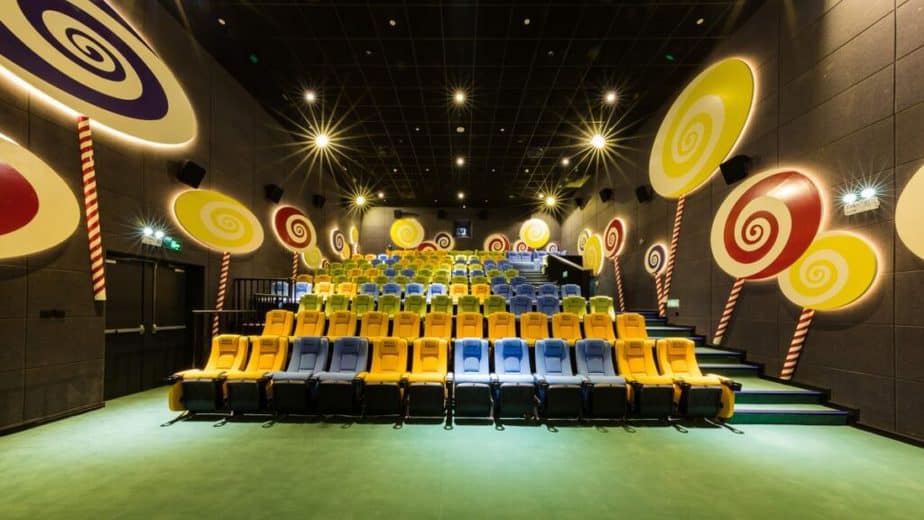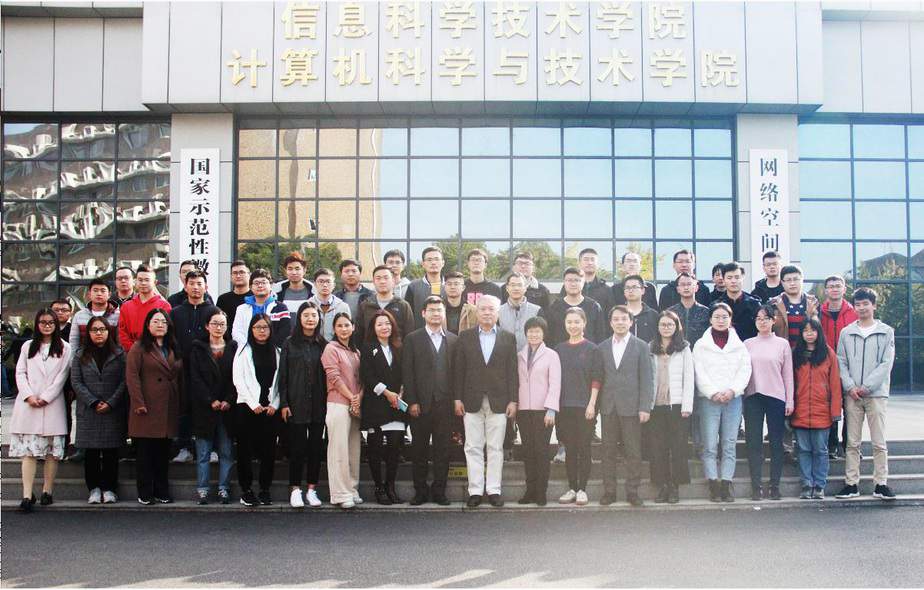Digital Decades
By Rebecca Pahle
GDC TECHNOLOGY CELEBRATES ITS 20TH YEAR

2020 marks the 20th year in operation for GDC Technology. Over the past two decades, the Hong Kong-based company has established itself as an industry leader in supplying digital cinema solutions, including media servers, integrated media blocks, and theatre management systems. As of November 2019, approximately one out of every three screens worldwide used some type of GDC product. Twenty-five of the top 30 chains count themselves as GDC customers.
GDC Technology began in 2000—but its story started years before. In 1996, Texas Instruments hosted a contest—the DSP Solutions Challenge—designed to encourage innovation in digital signal-processing technology. The team that won the $100,000 grand prize was led by Dr. Man-Nang Chong, then a professor at Nanyang Technological University in Singapore. The winning solution was a semi-automated restoration processing system whereby damaged motion picture film could be rid of scratches and marks. Dr. Chong would continue his work in the film-restoration field, but he remained intrigued by the advances being made in digital filmmaking and projection during that time.
“When I was working in film restoration, I thought that people would love to restore classics like Casablanca, Gone with the Wind, Hitchcock movies, James Bond, Truffaut. … Then I realized that the experts in Hollywood were not in the archival sections of these companies.”
It was the late ’90s. Texas Instruments debuted its DLP Cinema projector and Star Wars: Episode I—The Phantom Menace became the first film to be screened digitally. Dr. Chong knew that to be on the cutting edge of cinema technology meant going digital. So he did just that. “1999 was the year I sold my motion picture restoration company to Da Vinci [Technologies]. I registered a company to manufacture equipment and develop solutions for digital cinemas.” In 2000, GDC Technology was officially born.
That same year, GDC Technology became the first company to develop a software-based digital cinema server, allowing theatres to gain access to movies digitally, without spending thousands of dollars per film print. That high cost was particularly prohibitive for exhibitors in China, which at the time could typically only afford “a few hundred prints per blockbuster” at the maximum, explains Dr. Chong. “I saw the opportunities. I also went to India. These are developing countries that cannot afford to make too many analog prints. So I thought that the solution would be to use digital cinemas.”
“We started early” compared to other companies working in the digital cinema space, he notes. “But I thought the quality was good. … In those days, the projector’s resolution was not 4K. Not even 2K. It was 1.3K.” All the same, “I thought that the digital prints were definitely better than the film release prints. And the sound was so great because it was always 5.1 uncompressed PCM [pulse-code modulation] audio. I thought everything was great. I thought it was ready! [But] the cost of equipment was high; it was possibly almost 10 times the price of what projectors and media servers would cost today.”
“Year after year, the market for digital cinema didn’t take off,” he says. In fact, GDC Technology lost money for its first nine years. Dr. Chong likens digital cinema at the time to PLF (premium large-format) cinema today: a premium experience. Still, GDC stuck it out, holding to Dr. Chong’s philosophy of “listening to what the customer wants and what the industry needs.” In an era when so much of filmmaking was increasingly going digital, the industry needed an alternative to expensive, analog projection norms, even if it didn’t realize it yet.
During the first half of GDC’s existence, the company made technological strides, although it didn’t make money. In April 2002, they paid for two DLP Cinema projectors and installed them with GDC servers at China’s first two digital theatres, which in turn screened the country’s first digital print. In 2003, GDC introduced the DSR Digital Film Agile Encoder and DSR Digital Film Server, the first server capable of handling 2K resolution. Also in 2003, GDC digital servers entered the U.S. with an installation of its DSR server at the AMC in Santa Monica, California. In 2004, GDC brought 2K servers to Korea and China; in 2006, GDC servers were used for the Asian premiere of Columbia Pictures’ 3-D release Monster House. By the following year, the company signed an agreement with the China Film Group to install 700 2K digital cinema projection systems across the country. By the end of 2007, more than one thousand GDC 2K servers had been installed worldwide.
Then came the turning point. With the introduction of the virtual print fee, which allowed theatres to upgrade to digital projection with financial assistance from a coalition of major studios, exhibitors in North America transitioned to digital projection en masse within a relatively short span of time. “The market did not take off until 2008 when the VPF business models championed by Hollywood were accepted by exhibitors for only one good reason: 3-D,” says Dr. Chong. “3-D really created a catalyst for exhibitors to quickly jump on the bandwagon” of digital projection.
Though the high cost and unfamiliar technology initially bred skepticism among some exhibitors, “after they saw the big box office—I believe at that time 3-D ticket prices were 25, 30 percent more than the average ticket price—everyone jumped in.” And GDC Technology, with years of developing digital tools for cinemas already under its belt, was more than ready to meet them.
When the shift to digital happened, “we were fortunate enough to be in a position to mass-produce equipment. In the heydays of 2008 and 2009, we were producing close to 10,000 media servers a year. Before that, selling one digital cinema screen was like, ‘Wow!’ A big celebration. Selling 10 meant we were having champagne!”
Growth from there was exponential, both in North American and in Asian markets. GDC’s first major U.S. contract, inked in April of 2009, was to install 99 servers for Premiere Cinemas. In December of that year, GDC signed VPF agreements with major studios and contributed to the digital transition of major cinema chains in Japan and Hong Kong. A year later, GDC’s VPF program expanded to North and South America. By 2007, as previously noted, GDC had installed more than 1,000 2K servers worldwide; fewer than five years later, in 2011, that number had ballooned to 10,000-plus.
The technological innovations, too, kept on coming. In 2004, with a grant from Singapore’s Media Development Authority (MDA), GDC installed the world’s first entirely digital cinema multiplexes with GDC’s TMS (Theater Management System). In 2010, GDC provided a live-content decoder plug-in for its media servers, installed at Lotte Cinema for the Live 3D FIFA World Cup. In 2015, partnering with DTS Inc., GDC produced and installed the world’s first DTS:X media servers in China. The world’s first DTS:X-encoded movie, Monk Comes Down the Mountain, premiered in Beijing immediately following the installations. In 2017, in collaboration with Samsung, came the world’s first LED screen, installed at the Lotte Cinema World Tower in Seoul, South Korea.

And then, last year, the announcement of the Cinity Cinema System: a combined venture among GDC, Huaxia Film, and Christie Digital Systems meant to encourage advanced filmmaking formats. Director Ang Lee’s Gemini Man—filmed in 120FPS, 4K, 3-D—was released with the support of the GDC SR-6400C media servers, capable of running 240FPS, 4K, 3-D footage with two projector systems.
On the subject of Cinity, Dr. Chong says, “We had the computing power already. No one had really approached us until Huaxia and Ang Lee said that they really believe in this super-realistic type of motion picture exhibition. I saw the demonstration. I thought it was like a different canvas altogether. The 3-D, the high brightness, high dynamic range, and high frame rate, it makes the exhibition of the movies so real. … We created the technology as if it were a new canvas for painters. Sometimes you have to be patient. You create the technology, you create the canvas, and you wait. Some great artist will come and paint a good picture, tell a good story, and people will enjoy it.”
Cinity, notes Dr. Chong, represents the “high end” of digital projection. But it’s by no stretch of the imagination the only arena that GDC is interested in. The company has worked with Sony and Texas Instruments, Dr. Chong notes, to “produce projectors that are quiet and light enough—and have DCI compliance—to be installed in the home, in hotels, [and] in small-size mini-theatres. Because these are low-brightness projectors in the range of 5,000 lumens with a laser light source, they are very reliable.” Their 35dB ambient noise means “they’re quieter than air conditioners.” Oftentimes, these projectors are small enough so as to not require a standard projection booth; that was the case with Cinema Automation 2.0, a fully automatic, boothless cinema presented by GDC at CineAsia 2017.
The smaller, more compact projection and integrated media block technology that GDC is developing opens the door for nontraditional exhibition options. Dr. Chong touts iconic department store Selfridges in the UK, which in autumn of 2019 announced that it will add a cinema to its London flagship location.
“These are small theatres where the height of the ceiling is no more than 12 to 15 feet,” Dr Chong says of these more compact locations. “Both Texas Instruments and Sony saw the opportunity and approached GDC in 2017. We believe we have the best technology in terms of making the media servers reliably and also making them cost effective enough to be used for different markets.”
It’s that diversity of formats—every-thing from a theater in a department store to the world’s first LED screen—that Dr. Chong says he loves about the movie industry, and what GDC is able to contribute to it. “I see cinemas evolving to meet different needs,” he explains. “The old days of one gigantic screen for everyone to watch has evolved into different forms. Hopefully GDC will be relevant in whatever forms [cinema] keeps evolving into, whether it’s high end like Cinity or mini-theaters. I hope to play a part in this exciting growth.”
GDC Looks to the Future With Computer Science Scholarship

“I believe in scholarship. I benefited from it,” says Dr. Man-Nang Chong. The future chairman, CEO, and founder of GDC Technology studied in Scotland in the 1980s, specializing in electronics and later computer science and image pro–cessing. Because he did not come from a wealthy family, Dr. Chong would later reflect, without financial assistance he would not have been able to “complete my Ph.D. I would not have been able to achieve what I have achieved today and have contributed to the digital cinema industry.”
In 2012, Dr. Chong began paying it forward with its GDC Scholarship. Granted to between 30 and 50 students every year, the scholarship is given in cooperation with the University of Science and Technology of China (USTC) to undergraduate and postgraduate students from three USTC colleges: the School of Computer Science and Technology, the School of Information Science and Technology, and the School of Software Engineering.
The scholarship, explains Dr. Chong, is a way for him to “repay society” for the help he was given decades prior. More than that, however, the GDC Scholarship is intended to “encourage today’s engineers or engineers-to-be to think more about media technology,” specifically when it comes to cinemas. “We wanted to [encourage] bright engineers to think about what they can do for the industry—not just apps or other technology!”
“I think education is so important,” continues Dr. Chong. “It can change a person.” Through the GDC Scholarship, Dr. Chong says he hopes to motivate, encourage, and inspire future innovators in the cinema-technology industry. “We hope to continue to contribute and to make exhibitors and moviegoers happy,” he says. “Most important are the moviegoers, [that they] experience these new technologies in the cinema, so they keep coming back instead of watching movies on their iPads, their phones, or their tablets. This is what we want to do:”—through GDC’s technology and its contributions to future genera–tions—“Make [theaters] innovative to bring in more moviegoers.”
